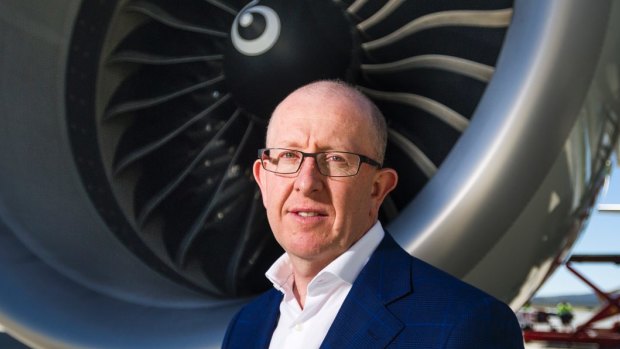By Steven Trask
The number of international travellers flying out of Canberra Airport is booming, according to new government statistics.
Between April 2017 and April 2018 there had been a 29.6 per cent increase in passengers flying out of the capital to international destinations, Canberra Airport managing director Stephen Byron said.

Airport chief Stephen Byron said news of growth in international passenger numbers was "fantastic".Credit: Dion Georgopoulos
Although the increase had come off a smaller base compared to larger airports, this was still the biggest increase in Australia for April, he added.
When domestic and international flights were combined, there had been a 9 per cent increase in total passengers flying out of Canberra when April 2017 was compared with April 2018.
This was the largest increase for an airport in a major Australian city.
The statistics compared passenger movements in April 2017 and April 2018.
A new aviation activity report released by the federal transport bureau was also encouraging for Canberra Airport, Mr Byron said.
This report compared passenger movements in May 2017 with those in May 2018.
Flights from Adelaide to Canberra had the greatest increase in the number of passengers over this period, with a 21.1 per cent lift described as “fantastic news” by Mr Byron.
Brisbane to Canberra flights carried 10 per cent more passengers in May 2018 than May 2017, and Canberra to Melbourne flights carried 7.8 per cent more passengers over the past year.
In the year between May 2017 and May 2018 total passenger movements out of Canberra Airport grew by 5 per cent, second only to Hobart (6.5 per cent) in Australia’s top 10 airports.
Canberra Airport has also recently launched a new facial recognition system to bolster security in sterile and high-security areas.
“We no longer want to rely on security cards and keys alone to secure the most sensitive areas of the airport,” Mr Byron said.
“We believe the bar must be set higher than that.”
The system only applies to employees and contractors working in sensitive areas of the airport, and is not used on passengers in public areas.
“We wanted the best technology to verify people meet three critical requirements,” Mr Byron said.
“[That] people are who they say they are, they are only allowed to be in areas where they are authorised to be, and they are there only at authorised times.
“This system does all of that in about a second.”